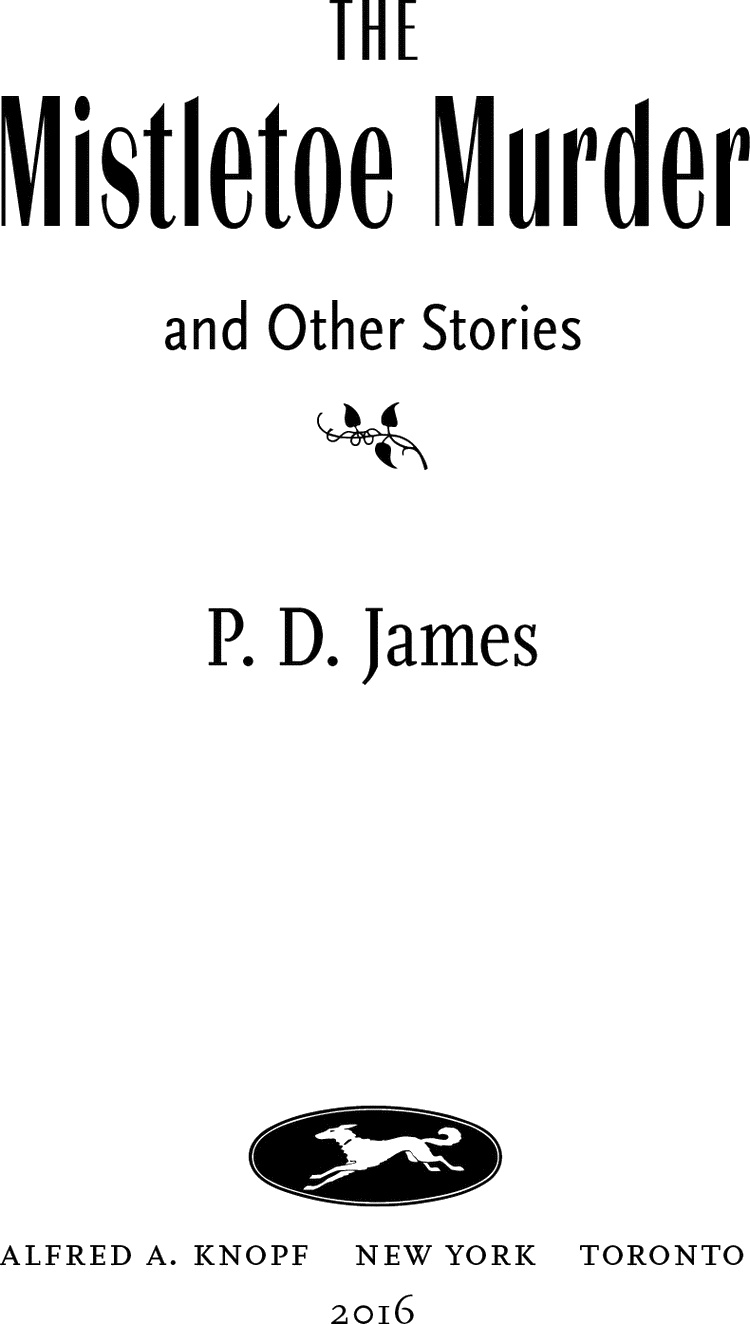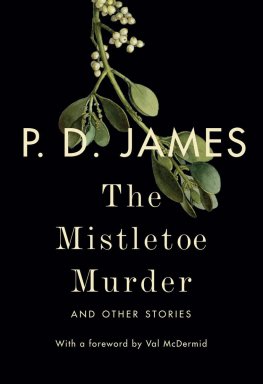The Mistletoe Murder
and Other Stories
P. D. James

ALSO BY P. D. JAMES Fiction
Cover Her Face
A Mind to Murder
Unnatural Causes
Shroud for a Nightingale
An Unsuitable Job for a Woman
The Black Tower Death of an Expert Witness
Innocent Blood
The Skull Beneath the Skin
Devices and Desires
The Children of Men
Original Sin
A Certain Justice
Death in Holy Orders
The Murder Room
The Lighthouse
The Private Patient
Death Comes to Pemberley Nonfiction
The Maul and the Pear Tree: The Ratcliffe Highway Murders, 1811 (with T. A. Critchley)
Time to Be in Earnest: A Fragment of Autobiography
Talking About Detective Fiction
Like so many crime writers, P. D. James was drawn to her vocation out of love. Before she took up her pen, she was a keen reader of detective novels, and over her long career she remained fascinated by the so-called Golden Age that followed the end of the First World War. But she was more than a fan. She applied her keen intelligence to what she read and developed a genuine expertise on the subject. I once heard her lecture on the four Queens of CrimeDorothy L. Sayers, Agatha Christie, Margery Allingham and Ngaio Marshand she even wrote a fascinating monograph on the subject, Talking About Detective Fiction. That love for the work of her predecessors is evident in this collection of her short stories: she picks the pockets of the mechanics of Golden Age plotting; Agatha Christie is referenced several times; and there are knowing nods to the conventions of traditional cosy mystery stories.
This appropriation of the conventions of the past sometimes misleads people into thinking of P. D. James as a cosy writer. The reality is that she was anything but cosy, and she takes on those conventions only to subvert them in an often witty way. But one thing in particular sets P. D. James apart from the mainstream tradition of Golden Age English crime fiction, with its stately homes and bourgeois villages where reality never rears its ill-mannered head. She understands that murder is nasty and brutal, that it is fuelled by the most malevolent of motives, and shes not afraid to face that darkness head-on. Her understanding of what she often called wickedness is creepily accurate. Theres nothing cosy about the murders in these stories, however much the settings mimic their forerunners.
And those settings are another hallmark of P. D. Jamess work. Her stories are always very specifically located in terms both of time and place. She is meticulous in her descriptions, summoning up backdrops against which we can readily picture the events as they unfold. She makes those settings work for a livingthey create atmosphere and often foreshadow what is to come. Here is our first sight of Stutleigh Manor: It loomed up out of the darkness, a stark shape against a grey sky pierced with a few high stars. And then the moon moved from behind a cloud and the house was revealed; beauty, symmetry and mystery bathed in white light. We know right now that something sinister and mysterious lies ahead.
As well as wickedness, P. D. James understood the importance of respectability. She wrote about people who would kill to preserve reputation and status, but who would never do it in a vulgar way. Her elegant prose always plays fair with the reader, and lulls us into a sense of false security, as her killers try to do. Behind those untroubled faades, the malice and suspense build, taking us to places that are dark, vicious and shocking. But always beautifully written. These stories are a delicious gift to us at a time when we thought we would read no more of P. D. Jamess work.
VAL McDERMID
In her introduction to an anthology of short crime stories published in 1934, Dorothy L. Sayers wrote: Death seems to provide the minds of the Anglo-Saxon race with a greater fund of innocent amusement than any other single subject. She was, of course, writing not of the horrifying, messy and occasionally pathetic murders of real life, but of the mysterious, elegantly contrived and popular concoctions of crime writers. Perhaps amusement is hardly the word; entertainment, relaxation or excitement would all be more appropriate. And, to judge from the universal popularity of crime writing, it isnt only the Anglo-Saxons who evince enthusiasm for murder most foul. Millions of readers throughout the world are at home in Sherlock Holmess claustrophobic sanctum at 221b Baker Street, Miss Marpless charming cottage in St. Mary Mead, and Lord Peter Wimseys elegant Piccadilly flat.
In the period leading up to the Second World War, much of crime writing was done in the form of a short story. The two writers who can be regarded as the founding fathers of the detective story, Edgar Allan Poe and Sir Arthur Conan Doyle, were both masters of the form, and the former adumbrated most of the distinguishing features not only of the short story, but of the crime novel: the least likely suspect as murderer, the closed-room mystery, the case solved by an armchair detective, and the epistolary narrative. Eric Ambler has written: The Detective story may have been born in the mind of Edgar Allan Poe, but it was London that fed it, clothed it and brought it to maturity. He was, of course, thinking of the genius of Conan Doyle, creator of the most famous detective in literature. He bequeathed to the genre a respect for reason, a non-abstract intellectualism, a reliance on ratiocination rather than on physical force, an abhorrence of sentimentality and the power to create an atmosphere of mystery and gothic horror which is yet firmly rooted in physical reality. Above all, more than any other writer he established the tradition of the great detective, that omniscient amateur whose personal, sometimes bizarre eccentricity is contrasted with the rationality of his methods and who provides for the reader the comforting reassurance that, despite our apparent powerlessness, we yet inhabit an intelligible universe.
Although the Sherlock Holmes stories are the most famous of this period, they are not the only ones worth re-reading. Julian Symons, a respected critic of crime fiction, pointed out that most of the notable practitioners in the art of the short story turned to detection as a relief from their other work and enjoyed using a form still in its infancy which offered them infinite opportunities for originality and variation. G. K. Chesterton is an example of a writer whose main interest lay elsewhere but whose Father Brown stories are still read with pleasure. And it is surprising how many other distinguished writers tried their hand at the short crime story. In the second series of Great Stories of Detection, Mystery and Horror, published in 1931, the contributors included H. G. Wells, Wilkie Collins, Walter de la Mare, Charles Dickens and Arthur Quiller-Couch, in addition to the names we would expect to find.
Few detective novelists writing today are uninfluenced by the founding fathers, but most crime writers produce novels rather than short stories. Part of the reason for this is the greatly reduced market for short stories generally, but the main reason is perhaps that the detective story has moved closer to mainstream fiction and a writer needs space if he or she is fully to explore the psychological subtleties of character, the complications of relationships, and the impact of murder and of a police investigation on the lives of those characters.











 ALSO BY P. D. JAMES Fiction
ALSO BY P. D. JAMES Fiction